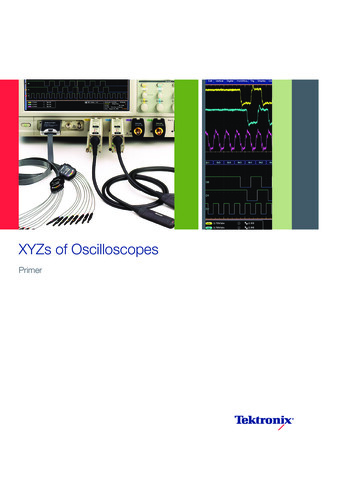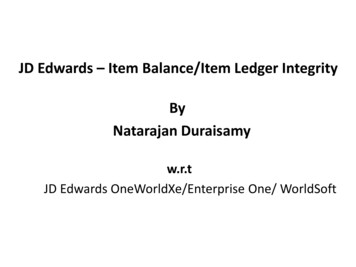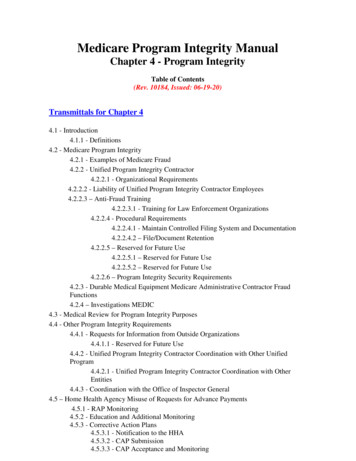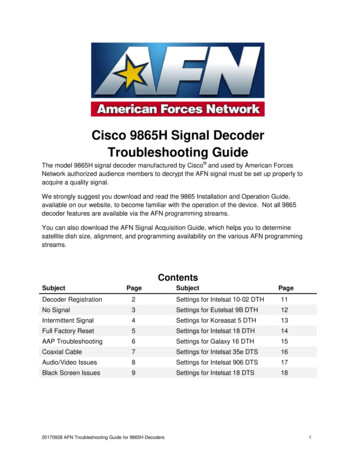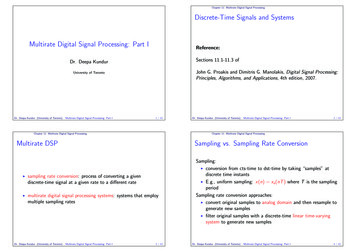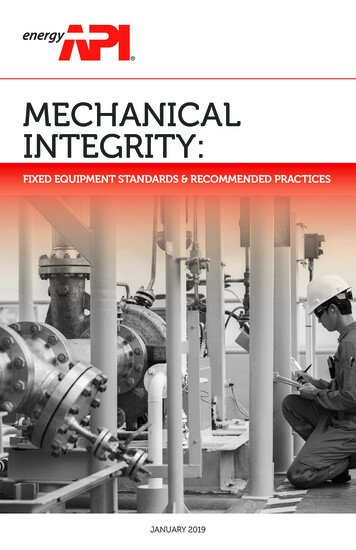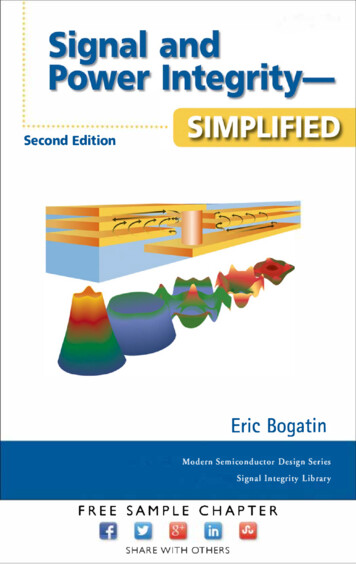
Transcription
Second EditionEric BogatinModern Semiconductor Design SeriesSignal Integrity LibraryFREE SAMPLE CHAPTERSHARE WITH OTHERS
SIGNAL ANDPOWERINTEGRITY–SIMPLIFIEDSECOND EDITION
Modern Semiconductor Design SeriesJames R. Armstrong and F. Gail GrayVHDL Design Representation and SynthesisMark Gordon ArnoldVerilog Digital Computer Design: Algorithms into HardwareJayaram BhaskerA VHDL Primer, Third EditionMark D. BirnbaumEssential Electronic Design Automation (EDA)Eric BogatinSignal and Power Integrity—Simplified, Second EditionDouglas BrooksSignal Integrity Issues and Printed Circuit Board DesignKen CoffmanReal World FPGA Design with VerilogAlfred CrouchDesign-for-Test for Digital IC’s and Embedded Core SystemsDennis Derickson and Marcus Müller (Editors)Digital Communications Test and MeasurementGreg EdlundTiming Analysis and Simulation for Signal Integrity EngineersDaniel FotyMOSFET Modeling with SPICE: Principles and PracticeTom GranbergHandbook of Digital Techniques for High-Speed DesignNigel Horspool and Peter GormanThe ASIC HandbookWilliam K. LamHardware Design VerificationGeoff Lawday, David Ireland, and Greg EdlundA Signal Integrity Engineer’s CompanionMike Peng LiJitter, Noise, and Signal Integrity at High-SpeedFarzad Nekoogar and Faranak NekoogarFrom ASICs to SOCs: A Practical ApproachFarzad NekoogarTiming Verification of Application-Specific Integrated Circuits (ASICs)Samir PalnitkarDesign Verification with eDavid Pellerin and Scott ThibaultPractical FPGA Programming in CChristopher T. RobertsonPrinted Circuit Board Designer’s Reference: BasicsChris RowenEngineering the Complex SOCMadhavan Swaminathan and A. Ege EnginPower Integrity Modeling and Design for Semiconductors and SystemsWayne WolfFPGA-Based System DesignWayne WolfModern VLSI Design, Fourth Edition: IP-Based Design
SIGNAL ANDPOWERINTEGRITY–SIMPLIFIEDSECOND EDITIONEric BogatinUpper Saddle River, NJ Boston Indianapolis San FranciscoNew York Toronto Montreal London Munich Paris MadridCapetown Sydney Tokyo Singapore Mexico City
Many of the designations used by manufacturers and sellers to distinguish their products are claimed as trademarks.Where those designations appear in this book, and the publisher was aware of a trademark claim, the designations havebeen printed with initial capital letters or in all capitals.The author and publisher have taken care in the preparation of this book, but make no expressed or implied warranty ofany kind and assume no responsibility for errors or omissions. No liability is assumed for incidental or consequentialdamages in connection with or arising out of the use of the information or programs contained herein.The publisher offers excellent discounts on this book when ordered in quantity for bulk purchases or special sales, whichmay include electronic versions and/or custom covers and content particular to your business, training goals, marketingfocus, and branding interests. For more information, please contact:U.S. Corporate and Government Sales(800) 382-3419corpsales@pearsontechgroup.comFor sales outside the United States, please contact:International Salesinternational@pearson.comVisit us on the Web: informit.comLibrary of Congress Cataloging-in-Publication DataBogatin, Eric.Signal and power integrity—simplified / Eric Bogatin. —2nd ed.p. cm.Rev. ed. of: Signal and power integrity—simplified / Eric Bogatin. c2004.Includes bibliographical references and index.ISBN-10: 0-13-234979-5 (hardcover : alk. paper)ISBN-13: 978-0-13-234979-6 (hardcover : alk. paper)1. Signal processing—Digital techniques. 2. Impedance (Electricity) 3.Signal integrity (Electronics) I. Bogatin, Eric. Signalintegrity—simplified. II. Title.TK5102.9.B58 2010621.382'2—dc222009021261Copyright 2010 Pearson Education, Inc.All rights reserved. Printed in the United States of America. This publication is protected by copyright, and permissionmust be obtained from the publisher prior to any prohibited reproduction, storage in a retrieval system, or transmission inany form or by any means, electronic, mechanical, photocopying, recording, or likewise. To obtain permission to usematerial from this work, please submit a written request to Pearson Education, Inc., Permissions Department, One LakeStreet, Upper Saddle River, New Jersey 07458, or you may fax your request to (201) 236-3290.ISBN-13: 978-0-13-234979-6ISBN-10:0-13-234979-5Text printed in the United States on recycled paper at Edwards Brothers in Ann Arbor, Michigan.Fourth printing, November 2013
The dedication of a book is called “The Dedication”because it requires dedication by the author to complete thework. As every author will tell you, writing is a solitary,alone process, the opposite of social activity. It’s easy tobecome engulfed in the writing and researching and excludemore and more of the real world. Successful authors areeither not married or married to an understanding, supportive spouse who sees his or her role as providing a nurturingenvironment in which creative juices can ferment.Susan, my wife, patiently put up with my solitary writing,giving me the space to put in the dedication to finish the firstand second editions. At the same time, she was also myanchor to the real world and forced me to keep a healthybalance between alone work and social life. The second edition is as much due to her efforts as from mine, and as I getto write the words, I am dedicating the second edition to her.
This page intentionally left blank
C O N T E N T SPreface to the Second EditionPreface to the First EditionxviiAcknowledgmentsxxiiiAbout the AuthorxxvChapter 15Signal Integrity Is in Your FutureWhat Is Signal Integrity?Signal Quality on a Single NetCross TalkRail-Collapse NoiseElectromagnetic Interference (EMI)Two Important Signal Integrity GeneralizationsTrends in Electronic ProductsThe Need for a New Design MethodologyA New Product Design MethodologySimulationsModeling and ModelsCreating Circuit Models from CalculationThree Types of MeasurementsThe Role of MeasurementsThe Bottom LineChapter 22.12.22.32.42.52.6xvTime and Frequency DomainsThe Time DomainSine Waves in the Frequency DomainShorter Time to a Solution in the Frequency DomainSine Wave FeaturesThe Fourier TransformThe Spectrum of a Repetitive 3
.17The Spectrum of an Ideal Square WaveFrom the Frequency Domain to the Time DomainEffect of Bandwidth on Rise TimeBandwidth and Rise TimeWhat Does Significant Mean?Bandwidth of Real SignalsBandwidth and Clock FrequencyBandwidth of a MeasurementBandwidth of a ModelBandwidth of an InterconnectThe Bottom LineImpedance and Electrical Models81Describing Signal-Integrity Solutions in Terms of ImpedanceWhat Is Impedance?Real Versus Ideal Circuit ElementsImpedance of an Ideal Resistor in the Time DomainImpedance of an Ideal Capacitor in the Time DomainImpedance of an Ideal Inductor in the Time DomainImpedance in the Frequency DomainEquivalent Electrical Circuit ModelsCircuit Theory and SPICEIntroduction to ModelingThe Bottom Line8284868889929499101105110Chapter 33.13.23.33.43.53.63.73.83.93.103.11Chapter 44.14.24.34.44.54.6The Physical Basis of ResistanceTranslating Physical Design into Electrical PerformanceThe Only Good Approximation for the Resistance of InterconnectsBulk ResistivityResistance per LengthSheet ResistanceThe Bottom LineChapter 55.15.25.35.45557586263676870727478The Physical Basis of CapacitanceCurrent Flow in CapacitorsThe Capacitance of a SphereParallel Plate ApproximationDielectric Constant113114115118119121124127128130131133
Contents5.55.65.75.85.9ixPower and Ground Planes and Decoupling CapacitanceCapacitance per Length2D Field SolversEffective Dielectric ConstantThe Bottom Line135138143146150The Physical Basis of Inductance151Chapter 156.166.176.186.19What Is Inductance?Inductance Principle #1: There Are Circular Rings of Magnetic-FieldLines Around All CurrentsInductance Principle #2: Inductance Is the Number of Webers of FieldLine Rings Around a Conductor per Amp of Current Through ItSelf-Inductance and Mutual InductanceInductance Principle #3: When the Number of Field Line RingsAround a Conductor Changes, There Will Be a Voltage InducedAcross the Ends of the ConductorPartial InductanceEffective, Total, or Net Inductance and Ground BounceLoop Self- and Mutual InductanceThe Power-Distribution Network (PDN) and Loop InductanceLoop Inductance per Square of PlanesLoop Inductance of Planes and Via ContactsLoop Inductance of Planes with a Field of Clearance HolesLoop Mutual InductanceEquivalent Inductance of Multiple InductorsSummary of InductanceCurrent Distributions and Skin DepthHigh-Permeability MaterialsEddy CurrentsThe Bottom LineChapter 77.17.27.37.47.57.6The Physical Basis of Transmission LinesForget the Word GroundThe SignalUniform Transmission LinesThe Speed of Electrons in CopperThe Speed of a Signal in a Transmission LineSpatial Extent of the Leading 93202204206209210211212214215219
7.187.197.20“Be the Signal”The Instantaneous Impedance of a Transmission LineCharacteristic Impedance and Controlled ImpedanceFamous Characteristic ImpedancesThe Impedance of a Transmission LineDriving a Transmission LineReturn PathsWhen Return Paths Switch Reference PlanesA First-Order Model of a Transmission LineCalculating Characteristic Impedance with ApproximationsCalculating the Characteristic Impedance with a 2D Field SolverAn n-Section Lumped Circuit ModelFrequency Variation of the Characteristic ImpedanceThe Bottom LineChapter 158.168.178.188.198.20Transmission Lines and ReflectionsReflections at Impedance ChangesWhy Are There Reflections?Reflections from Resistive LoadsSource ImpedanceBounce DiagramsSimulating Reflected WaveformsMeasuring Reflections with a TDRTransmission Lines and Unintentional DiscontinuitiesWhen to TerminateThe Most Common Termination Strategy for Point-to-Point TopologyReflections from Short Series Transmission LinesReflections from Short-Stub Transmission LinesReflections from Capacitive End TerminationsReflections from Capacitive Loads in the Middle of a TraceCapacitive Delay AddersEffects of Corners and ViasLoaded LinesReflections from Inductive DiscontinuitiesCompensationThe Bottom 327331334
ContentsxiLossy Lines, Rise-Time Degradation,and Material PropertiesChapter 159.169.17Why Worry About Lossy Lines?Losses in Transmission LinesSources of Loss: Conductor Resistance and Skin DepthSources of Loss: The DielectricDissipation FactorThe Real Meaning of Dissipation FactorModeling Lossy Transmission LinesCharacteristic Impedance of a Lossy Transmission LineSignal Velocity in a Lossy Transmission LineAttenuation and the dBAttenuation in Lossy LinesMeasured Properties of a Lossy Line in the Frequency DomainThe Bandwidth of an InterconnectTime-Domain Behavior of Lossy LinesImproving the Eye Diagram of a Transmission LinePre-emphasis and EqualizationThe Bottom LineChapter .1210.1310.1410.1510.1610.17Cross Talk in Transmission LinesSuperpositionOrigin of Coupling: Capacitance and InductanceCross Talk in Transmission Lines: NEXT and FEXTDescribing Cross TalkThe SPICE Capacitance MatrixThe Maxwell Capacitance Matrix and 2D Field SolversThe Inductance MatrixCross Talk in Uniform Transmission Lines and Saturation LengthCapacitively Coupled CurrentsInductively Coupled CurrentsNear-End Cross TalkFar-End Cross TalkDecreasing Far-End Cross TalkSimulating Cross TalkGuard TracesCross Talk and Dielectric ConstantCross Talk and 48451457464466
xiiContents10.1810.1910.20Switching NoiseSummary of Reducing Cross TalkThe Bottom LineDifferential Pairs and DifferentialImpedance469473474Chapter .22Differential SignalingA Differential PairDifferential Impedance with No CouplingThe Impact from CouplingCalculating Differential ImpedanceThe Return-Current Distribution in a Differential PairOdd and Even ModesDifferential Impedance and Odd-Mode ImpedanceCommon Impedance and Even-Mode ImpedanceDifferential and Common Signals and Odd- and Even-ModeVoltage ComponentsVelocity of Each Mode and Far-End Cross TalkIdeal Coupled Transmission-Line Model or an Ideal Differential PairMeasuring Even- and Odd-Mode ImpedanceTerminating Differential and Common SignalsConversion of Differential to Common SignalsEMI and Common SignalsCross Talk in Differential PairsCrossing a Gap in the Return PathTo Tightly Couple or Not to Tightly CoupleCalculating Odd and Even Modes from Capacitance- andInductance-Matrix ElementsThe Characteristic Impedance MatrixThe Bottom LineS-Parameters for Signal 8511513519520522529534539542544546550553Chapter 1212.112.212.312.412.5S-Parameters, the New Universal MetricWhat Are S-Parameters?Basic S-Parameter FormalismS-Parameter Matrix ElementsSimulating Return and Insertion Loss555555557559562567
2.1512.1612.1712.18xiiiA Transparent InterconnectChanging the Port ImpedanceThe Phase of S21 for a Uniform 50-Ohm Transmission LineThe Magnitude of S21 for a Uniform Transmission LineCoupling to Other Transmission LinesInsertion Loss for Non-50-Ohm Transmission LinesData-Mining S-ParametersSingle-Ended and Differential S-ParametersDifferential Insertion LossThe Mode Conversion TermsConverting to Mixed-Mode S-ParametersTime and Frequency DomainsThe Bottom LineChapter e Power Distribution Network (PDN)The ProblemThe Root CauseThe Most Important Design Guidelines for the PDNEstablishing the Target Impedance Is HardEvery Product Has a Unique PDN RequirementEngineering the PDNThe VRMSimulating Impedance with SPICEOn-die CapacitanceThe Package BarrierThe PDN with No Decoupling CapacitorsThe MLCC CapacitorThe Equivalent Series InductanceApproximating Loop InductanceOptimizing the Mounting of CapacitorsCombining Capacitors in ParallelEngineering a Reduced Parallel Resonant Peak by AddingMore CapacitorsSelecting Capacitor ValuesEstimating the Number of Capacitors NeededHow Much Does a nH Cost?Quantity or Specific 675681683687
pting the Impedance Profiles: The Frequency Domain TargetImpedance (FDTI) MethodWhen Every pH CountsLocation, Location, LocationWhen Spreading Inductance Is the LimitationThe Chip ViewBringing It All TogetherThe Bottom Line692699703707710713717100 General Design Guidelines toMinimize Signal-Integrity Problems719100 Collected Rules of Thumb to HelpEstimate Signal-Integrity Effects727Appendix AAppendix BAppendix CIndexSelected References739741
P R E F A C E T O T H EE D I T I O NS E C O N DSince the publication of the first edition of Signal Integrity—Simplified, the principles of signal integrity haven’t changed. What has changed, though, is the prolificuse of high-speed serial links and the critical role power integrity now plays in thesuccess or failure of new product introductions.In addition to fleshing out more details and examples in many of the chapters, especially on differential pairs and losses, two new chapters have been addedto this second edition to provide a strong foundation to meet the needs of today’sengineers and designers.This first new chapter—Chapter 12—provides a thorough introduction to theuse of S-parameters in signal integrity applications. If you deal with any highspeed serial links, you will encounter S-parameters. Because they are written inthe foreign language of the frequency domain, they are intimidating to the highspeed digital designer. Chapter 12, like all the chapters in this book, provides asolid foundation in understanding this formalism and enables all engineers to harness the great power of S-parameters.Chapter 13, the second new chapter, is on power integrity. These issuesincreasingly fall in the lap of the design engineer. With higher speed applications,interconnects in the power distribution path affect not just power delivery, but alsosignals’ return paths and passing an EMC certification test.We start at the beginning and illustrate the role of the power distributioninterconnects and how design and technology selection can make or break the performance of the power distribution network. The essential principles of planexv
xviPreface to the Second Editionimpedance, spreading inductance, decoupling capacitors, and the loop inductanceof capacitors are introduced. This valuable insight helps feed the intuition of engineers enabling them to apply the power of their creativity to synthesize newdesigns. Hand in hand with the creation of a design is the analysis of its performance so that cost-performance trade-offs can be explored and the PDN impedance profile can be sculpted to perfection.If you are new to signal integrity, this second edition of Signal and PowerIntegrity—Simplified provides your starting place to build a strong foundation andempowers you to get your new signal integrity designs right the first time, everytime.
P R E F A C E T O T H EE D I T I O NF I R S T“Everything should be made as simple as possible, but not simpler.”Albert EinsteinPrinted circuit-board and IC-package design used to be a field that involved expertise in layout, CAD, logic design, heat transfer, mechanical engineering, and reliability analysis. With modern digital electronic systems pushing beyond the 1GHz barrier, packaging and board designers must now balance signal integrityand electrical performance with these other concerns.Everyone who touches the physical design of a product has the potential ofaffecting the performance. All designers should understand how what they do willaffect signal integrity or, at the very least, be able to talk with engineers who areresponsible for the signal integrity.The old design methodology of building prototypes, hoping they work, andthen testing them to find out is no longer cost effective when time to market is asimportant as cost and performance. If signal integrity is not taken into accountfrom the beginning, there is little hope a design will work the first time.In our new “high-speed” world, where the packaging and interconnect are nolonger electrically transparent to the signals, a new methodology for designing aproduct right the first time is needed. This new methodology is based on predictability. The first step is to use established design guidelines based on engineeringdiscipline. The second step is to evaluate the expected performance by “putting inthe numbers.” This is what distinguishes engineering from guesswork. It takesxvii
xviiiPreface to the First Editionadvantage of four important tools: rules of thumb, analytic approximations,numerical simulation tools, and measurements. With an efficient design and simulation process, many of the trade-offs between the expected performance and theultimate cost can be evaluated early in the design cycle, where the time, risk, andcost savings will have the biggest impact. The way to solve signal integrity problems is to first understand their origin and then apply all the tools in our toolbox tofind and verify the optimum solution.The design process is an intuitive one. The source of inspiration for a newway of solving a problem is that mysterious world of imagination and creativity.An idea is generated and the analytical powers of our technical training take overto massage the idea into a practical solution. Though computer simulations areabsolutely necessary for final verification of a solution, they only rarely aid in ourintuitive understanding. Rather, it is an understanding of the mechanisms, principles and definitions, and exposure to the possibilities, that contribute to the creation of a solution. Arriving at that initial guess and knowing the places to look forsolutions require understanding and imagination.This book emphasizes the intuitive approach. It offers a framework forunderstanding the electrical properties of interconnects and materials that applyacross the entire hierarchy from on-chip, through the packages, circuit boards,connectors, and cables.Those struggling with the confusing and sometimes contradictory statementsmade in the trade press will use this book as their starting place. Those experienced in electrical design will use this book as the place to finally understand whatthe equations mean.In this book, terms are introduced starting at the ground floor. For example,the impedance of a transmission line is the most fundamental electrical propertyof an interconnect. It describes what a signal will see electrically and how it willinteract with the interconnects. For those new to signal integrity, most of the problems arise from confusion over three terms: the characteristic impedance, theimpedance, and the instantaneous impedance a signal sees. This distinction iseven important for experienced engineers. This book introduces the reader to eachof these terms and their meanings, without complex mathematics.New topics are introduced at a basic level; most are not covered in other signal integrity books at this level. These include partial inductance (as distinct fromloop inductance), the origin of ground bounce and EMI, impedance, transmissionline discontinuities, differential impedance, and attenuation in lossy lines affecting
Preface to the First Editionxixthe collapse of the eye diagram. These topics have become critically important forthe new high-speed serial links.In addition to understanding the basic principles, leveraging commerciallyavailable tools is critical for the practicing engineer who wants to find the bestanswer in the shortest time. Tools for solving signal integrity problems fall in twocategories: analysis and characterization. Analysis is what we usually refer to as acalculation. Characterization is what we usually refer to as a measurement. Thevarious tools, guidelines on when they should be used, and examples of their valueare presented throughout the book.There are three types of analysis tools: rules of thumb, analytic approximations, and numerical simulation. Each has a different balance between accuracyand effort to use. Each has a right and a wrong place for its appropriate use. Andeach tool is important and should be in the toolbox of every engineer.Rules of thumb, such as “the self inductance of a wire is about 25 nH/inch,”are important when having a quick answer NOW! is more important than havingan accurate answer later. With very few exceptions, every equation used in signalintegrity is either a definition or an approximation. Approximations are great forexploring design space and balancing design and performance trade-offs. However, without knowing how accurate a particular approximation really is, wouldyou want to risk a 10,000 board-fabrication run and four weeks of your schedulebased on an approximation?When accuracy is important, for example, when signing off on a design,numerical simulation is the right tool to use. In the last five years, a whole newgeneration of tools has become available. These new tools have the powerful combination of being both easy to use and accurate. They can predict the characteristicimpedance, cross talk, and differential impedance of any cross-section transmission line and simulate how a signal might be affected by any type of terminationscheme. You don’t have to be a Ph.D. to use this new generation of tools so thereis no reason every engineer can’t take advantage of them.The quality of the simulation is only as good as the quality of the electricaldescription of the components (i.e., the equivalent circuit models). Engineers aretaught about circuit models of gates that perform all the information processing,but rarely are the circuit models of the interconnects reviewed. Fifteen years ago,when interconnects looked transparent to the signals, all interconnects were considered as ideal wires—no impedance and no delay. When these terms wereadded, they were lumped together as “parasitics.”
xxPreface to the First EditionToday, in a high-speed digital system with a clock frequency above about100 MHz, it is the real wires—the wire bonds, the package leads, the pins, the circuit board traces, the connectors, and the cabling—that create signal-integrityproblems and can prevent products from working correctly the first time. Understanding these “analog” effects, designing for them, specifying correct values forthem, and including them in the system simulations before the design is committed to hardware, can enable moving a more robust product to market more quickly.This book provides the tools to enable all engineers and managers involvedin chip packaging and board, connector and interconnect design, to understandhow these passive elements affect the electrical performance of a system and howthey can be incorporated in system simulation. It illustrates how to perform engineering estimates of important electrical parameters and evaluate technologytrade-offs. Examples are selected from a wide variety of common systems, including on-chip interconnects, wire bonds, flip chip attach, multilayer circuit boards,DIPs, PGAs, BGAs, QFPs, MCM connectors, and cables.While most textbooks emphasize theoretical derivation and mathematicalrigor, this book emphasizes intuitive understanding, practical tools, and engineering discipline. We use the principles of electrical engineering and physicsand apply them to the world of packaging and interconnects to establish a framework of understanding and a methodology of solving problems. The tools oftime- and frequency-domain measurement, two- and three-dimensional fieldsolvers, transmission-line simulations, circuit simulators, and analytical approximations are introduced to build verified equivalent circuit models for packagesand interconnects.There are two important questions that all designers should ask of any modelthey use: How accurate is it? And what is the bandwidth of the model? Theanswers to these questions can come only from measurements. Measurementsplay the very important role of risk reduction.The three generic measurement instruments, the impedance analyzer, thevector-network analyzer (VNA) and the time-domain reflectometer (TDR) areintroduced and the interpretation of their data explained. Examples of measurements from real interconnects such as IC packages, printed circuit boards, cables,and connectors are included throughout this book to illustrate the principles and,by example, the value of characterization tools.This book has been designed for use by people of all levels of expertise andtraining: engineers, project managers, sales and marketing managers, technologydevelopers, and scientists. We start out with an overview of why designing the
Preface to the First Editionxxiinterconnects for high-speed digital systems is difficult and what major technicalhurdles must be overcome to reach high-frequency operation.We apply the tools of electrical engineering and physics to the problems ofsignal integrity in digital signals through the entire range of interconnects. Theconcept of equivalent circuit models is introduced to facilitate the quantifiedprediction of performance. The rest of the book describes how the circuit models of interconnects affect the electrical performance of the system in terms ofthe four families of noise problems: reflections, cross talk, rail collapse in thepower distribution network, and EMI.This book originated from a series of short courses and semester-longcourses the author gave to packaging, circuit-board, and design engineers. It is oriented to all people who need to balance electrical performance with all other packaging and interconnect concerns in their system designs. This book provides thefoundation to understand how the physical design world of geometries and material properties affects electrical performance.If you remember nothing else about signal integrity, you should rememberthe following important general principles. These are summarized here anddescribed in more detail throughout this book.Top Ten Signal Integrity Principles1. The key to efficient high-speed product design is to take advantage of analysis tools that enable accurate performance prediction. Use measurements asa way of validating the design process, reducing risk, and increasing confidence in the design tools.2. The only way to separate myth from reality is to put in the numbers usingrules of thumb, approximations, numerical simulation tools, or measurements. This is the essential element of engineering discipline.3. Each interconnect is a transmission line with a signal and a return path,regardless of its length, shape, or signal rise time. A signal sees an instantaneous impedance at each step along its way down an interconnect. Signalquality is dramatically improved if the instantaneous impedance is constant,as in a transmission line with a uniform cross section.4. Forget the word ground. More problems are created than solved by using thisterm. Every signal has a return path. Think return path and you will train
xxiiPreface to the First Editionyour intuition to look for and treat the return path as carefully as you treatthe signal path.5.
For sales outside the United States, please contact: International Sales international@pearson.com Visit us on the Web: informit.com Library of Congress Cataloging-in-Publication Data Bogatin, Eric. Signal and power integrity—simplified / Eric Bogatin. —2nd ed. p. cm. Rev. ed. of: Signal and power integrity—simplified / Eric Bogatin. c2004.
